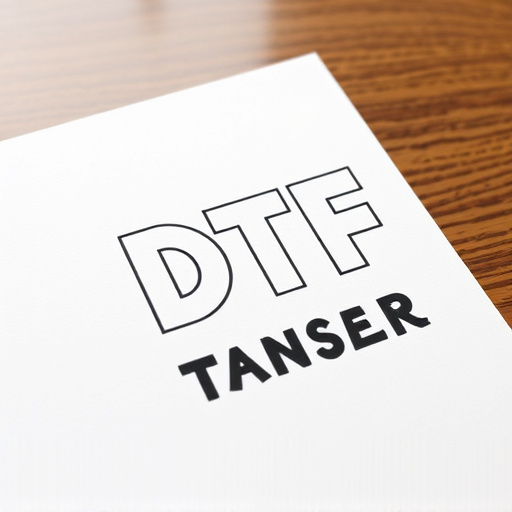Direct-to-film (DTF) printing offers superior design application on textiles, ceramics, and metal with high color accuracy and resolution. To start, secure quality DTF film, inks, and a compatible printer. Prepare artwork in high resolution (300dpi minimum) using graphic software, creating cutting paths for precise printing. Apply ink to the film, dry it, then press onto the target surface using a heat press. After curing, carefully lift the transfer from its backing, position on the substrate, and gently press for a crisp, bubble-free finish.
Discover the art of direct-to-film (DTF) printing with our comprehensive guide. Learn how to transform your designs into vibrant, permanent art on various surfaces. This step-by-step tutorial covers everything from understanding the DTF transfer process to applying and curing the ink. We’ll walk you through preparing your design, using the right equipment, and removing the film for a successful DTF transfer. Elevate your DIY projects with this powerful technique!
- Understanding Direct-to-Film (DTF) Transfer Process
- Necessary Equipment and Materials for DTF Printing
- Preparing Your Design for DTF Transfer
- Applying the DTF Ink and Pressing the Film
- Processing and Curing the Printed Film
- Removing and Applying the DTF Transfer to Your Substrate
Understanding Direct-to-Film (DTF) Transfer Process

Direct-to-film (DTF) transfer is a cutting-edge method for applying designs to various materials, including textiles, ceramics, and even metal. Unlike traditional printing methods that rely on separate inks and plates, DTF technology uses a direct ink jet process to precisely transfer intricate patterns and images onto the desired surface. This innovative approach offers several advantages, such as superior color accuracy, higher resolution, and the ability to print on unconventional shapes and textures.
The DTF transfer process involves several key steps: first, preparing the substrate by cleaning and treating it to ensure optimal ink adhesion. Then, using specialized software, the design is precisely aligned and sent to an inkjet printer that accurately deposits the pigment onto the material. This method allows for complex and detailed designs, making it ideal for creating custom patterns, logos, or artwork. Once printed, the ink undergoes a curing process, ensuring long-lasting durability and vibrancy.
Necessary Equipment and Materials for DTF Printing

To embark on your direct-to-film (DTF) printing journey, there are several essential tools and materials you’ll need to gather. The process requires specific items to ensure optimal results and a seamless experience. Firstly, secure a high-quality DTF transfer film that’s compatible with your printer. This film is the key component, allowing you to transfer intricate designs onto various surfaces. Along with the film, invest in a reliable printer that supports DTF capabilities, ensuring precise and crisp prints.
Additionally, prepare essential inks, curers, and cleaning supplies. DTF printing demands specialized inks formulated for this technique to achieve vibrant colours and sharp details. Curers are crucial for setting the ink quickly, while cleaning solutions help maintain the integrity of your equipment. Having spare nozzles and print heads on hand is also recommended to tackle any potential issues during the printing process.
Preparing Your Design for DTF Transfer

To prepare your design for a DTF (Direct-to-Film) transfer, start by ensuring your artwork is in a high-resolution digital format. This guarantees that the final print will be sharp and detailed. Use graphic design software to create or edit your image, making sure it aligns with the specifications of the material you plan to use. Consider factors like color mode (CMYK for printing), resolution (at least 300 dpi), and file type (JPEG, PNG, or SVG).
Next, prepare your design for cutting paths. If using a vector graphic program, create outline or cut lines around your design elements. These paths will guide the print head during the transfer process, ensuring precise cutting and placing of the design on the film. Test your design by printing a test strip to check for any potential issues before finalizing it for the actual DTF transfer.
Applying the DTF Ink and Pressing the Film

Applying the DTF (Direct-to-Film) Ink: The first step in creating your custom design is to accurately apply the DTF ink. Start by ensuring your work area is clean and prepared, with all necessary materials at hand. Prepare the DTF ink according to the manufacturer’s instructions, mixing it thoroughly if required. Using a precision tool or a brush designed for this purpose, carefully apply the ink onto the film, following the design or image you wish to transfer. Be mindful of any air bubbles or uneven application, as these can affect the final print quality.
Pressing the Film: Once the ink is dry (or as per the product’s instructions), it’s time to press the film onto your desired surface. Place the ink-side down on the target material, whether it’s fabric, paper, or another substrate. Use a heat press machine set at the recommended temperature and pressure for your DTF transfer. Apply even pressure across the entire area of the film, ensuring good contact with the substrate. The pressing time may vary depending on the materials and product instructions, so keep a close eye on it to achieve the best results.
Processing and Curing the Printed Film

After applying the direct-to-film (DTF) transfer, the next critical step is processing and curing the printed film. This involves several key actions to ensure optimal results. First, gently rinse the printed side of the film in cold water for about 30 seconds to remove any residual chemicals or ink. Then, place the film in a dry, clean environment, avoiding direct sunlight. Curing time can vary depending on the type of film and print, but typically ranges from 24 to 48 hours. During this period, the inks need to fully set and bond with the substrate. You may notice the colors darken slightly as they cure, which is a normal part of the process. Ensure proper ventilation in the curing area to prevent any buildup of fumes. Once cured, test the print quality by gently touching or blowing on it; if it feels dry and the inks are set, it’s ready for the next step in your project.
Removing and Applying the DTF Transfer to Your Substrate

After ensuring your substrate is clean and prepared, it’s time to remove the DTF transfer from its backing film. Start by gently peeling away one corner of the transfer, using a tool like a spatula or a flat-edge scraper. This allows you to lift an edge of the delicate print, making it easier to handle. Once you’ve gripped one side, carefully pull it straight up, ensuring not to stretch or distort the image.
With the DTF transfer now accessible, apply it precisely onto your substrate. Align it carefully, positioning it exactly where you want the design to appear. Press down gently on the transfer, making sure it makes full contact with the surface. This step ensures a crisp and clear print, free from bubbles or misalignments.














